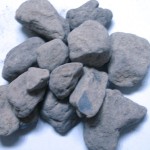

Bauxit
The initial production of aluminium from bauxite requires energy for mining, processing of ores, and for electrolysis processes. However, this one-time energy expenditure remains stored in the metal. After the operating life of an aluminium product has ended the latter can be smelt and cast again without diminishing the material's quality.
 The metallurgical properties of aluminium therefore allow near-complete recycling of the metal with a recovery rate of 95-99%. Extracting aluminium by remelting scrap results in energy savings of up to 95% compared to its production from aluminium oxide. [5] Therefore, aluminium scrap represents a valuable raw material for production.
In 1995 for example, 42% of the FRG's aluminium were produced from remelted aluminium and 58% were produced in electrolysis installations. [6] In Austria electrolysis is not used for extracting aluminium. However, approximately 130,000 tons of secondary aluminium are currently retained in facilities in Austria.[7]
CITATIONS
[5] Weber R., op. cit., p. 89.
[6] Kammer C., op. cit., p. 8
[7] Aluminium Initiative Austria, op. cit.
The metallurgical properties of aluminium therefore allow near-complete recycling of the metal with a recovery rate of 95-99%. Extracting aluminium by remelting scrap results in energy savings of up to 95% compared to its production from aluminium oxide. [5] Therefore, aluminium scrap represents a valuable raw material for production.
In 1995 for example, 42% of the FRG's aluminium were produced from remelted aluminium and 58% were produced in electrolysis installations. [6] In Austria electrolysis is not used for extracting aluminium. However, approximately 130,000 tons of secondary aluminium are currently retained in facilities in Austria.[7]
CITATIONS
[5] Weber R., op. cit., p. 89.
[6] Kammer C., op. cit., p. 8
[7] Aluminium Initiative Austria, op. cit.
 The metallurgical properties of aluminium therefore allow near-complete recycling of the metal with a recovery rate of 95-99%. Extracting aluminium by remelting scrap results in energy savings of up to 95% compared to its production from aluminium oxide. [5] Therefore, aluminium scrap represents a valuable raw material for production.
In 1995 for example, 42% of the FRG's aluminium were produced from remelted aluminium and 58% were produced in electrolysis installations. [6] In Austria electrolysis is not used for extracting aluminium. However, approximately 130,000 tons of secondary aluminium are currently retained in facilities in Austria.[7]
CITATIONS
[5] Weber R., op. cit., p. 89.
[6] Kammer C., op. cit., p. 8
[7] Aluminium Initiative Austria, op. cit.
The metallurgical properties of aluminium therefore allow near-complete recycling of the metal with a recovery rate of 95-99%. Extracting aluminium by remelting scrap results in energy savings of up to 95% compared to its production from aluminium oxide. [5] Therefore, aluminium scrap represents a valuable raw material for production.
In 1995 for example, 42% of the FRG's aluminium were produced from remelted aluminium and 58% were produced in electrolysis installations. [6] In Austria electrolysis is not used for extracting aluminium. However, approximately 130,000 tons of secondary aluminium are currently retained in facilities in Austria.[7]
CITATIONS
[5] Weber R., op. cit., p. 89.
[6] Kammer C., op. cit., p. 8
[7] Aluminium Initiative Austria, op. cit.
However, one of the most important characteristics for the environmental sustainability of the material aluminium is the continued existence of the energy originally invested in producing the metal allowing for multiple re-use and the highest possible conservation of resources.
Remelted aluminium produced from aluminium scrap requires only 5% of the energy needed for the production from aluminium oxide, but it fully corresponds to the original quality.
So once the aluminium is produced, it creates an "aluminium pool" allowing for numerous energy saving and cost-effective recycling processes of the raw material even after the operating life of a workpiece has ended.
Aluminium is the most abundant metal in the earth's crust and is therefore almost infinitely available. Approximately 20 million tons of aluminium are extracted from bauxite ores per year worldwide. Naturally the mining of raw materials requires surfaces and energy is used for the extraction of metal.
For years aluminium production has been carried out in an increasingly ecologically sustainable way by making use of the most modern technologies. Combined with the special qualities of a weather resistant light metal, aluminium is a material that meets the various challenges of our time.

 English
English Deutsch
Deutsch 